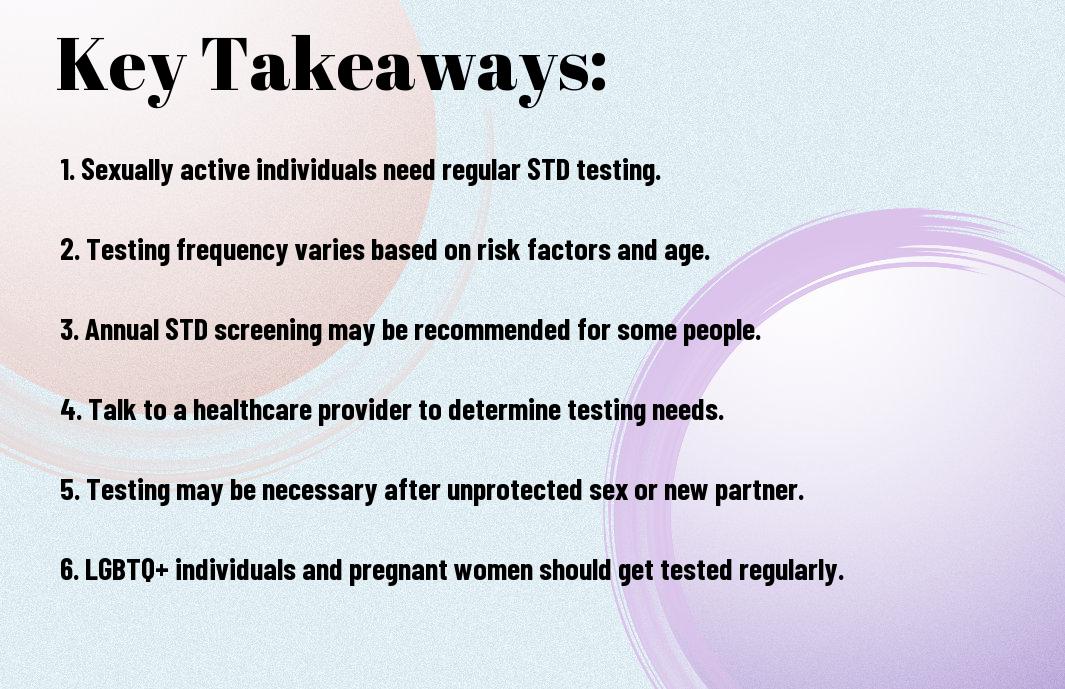Most individuals might not realize the importance of regular STD testing to protect their health and that of their partners. Knowing who needs to get tested and how often can make a significant impact on preventing the spread of sexually transmitted infections. In this informative guide, we will explore the individuals at high risk, the recommended frequency of testing, and why staying informed about your sexual health is crucial in today’s world.
Key Takeaways:
- Regular Testing: It is important for sexually active individuals to get tested for STDs regularly, even if they do not have any symptoms.
- Risk Factors: People with multiple sexual partners, those who do not consistently use condoms, and individuals with a history of STDs should consider getting tested more frequently.
- Consult a Healthcare Provider: It is vital to consult a healthcare provider to determine the appropriate testing frequency based on individual risk factors and sexual health history.

Who Needs an STD Test
Your sexual health is important, and getting tested for sexually transmitted diseases (STDs) is a crucial step in taking care of yourself. STD tests are recommended for anyone who is sexually active and wants to ensure their well-being and that of their partners. While it’s a good idea for everyone to get tested regularly, there are certain groups who are considered at higher risk and should especially prioritize getting tested.
High-Risk Groups
One group that falls into the high-risk category includes individuals who have had unprotected sex, especially with multiple partners. Other high-risk groups may include men who have sex with men, individuals with a history of STDs, and people who use intravenous drugs.
Individuals with Multiple Partners
Partners who have multiple sexual partners are at an increased risk of contracting STDs. Having multiple partners can increase the chances of exposure to infections and make it easier for STDs to spread. For these individuals, regular STD testing is crucial to ensure early detection and treatment if needed.
Multiple sexual partners means a higher likelihood of coming into contact with someone who has an STD, even if they are unaware of their infection status. It’s important to be proactive about your sexual health and get tested regularly to protect yourself and your partners.
Those Engaging in Unprotected Sex
On top of individuals with multiple partners, those who engage in unprotected sex are also at a higher risk of contracting STDs. Unprotected sex can lead to the transmission of various infections, including HIV, chlamydia, gonorrhea, and syphilis.
The use of condoms can significantly reduce the risk of STD transmission, but they are not foolproof. If you engage in unprotected sex, it’s imperative to get tested regularly to monitor your sexual health status and address any potential infections promptly.
People with Symptoms of STDs
For individuals experiencing symptoms such as unusual discharge, pain during urination, genital sores, or itching, getting tested for STDs is crucial. Early detection and treatment of STDs can prevent further complications and help protect both your health and that of your sexual partners.
STDs often present with symptoms that can be mistaken for other conditions, so it’s important not to ignore any signs of infection. If you experience any unusual symptoms related to your sexual health, don’t hesitate to seek medical advice and get tested for STDs as needed.
How Often to Get Tested
After Unprotected Sex or a New Partner
With the risk of contracting sexually transmitted infections (STIs) heightened after unprotected sex or engaging with a new partner, it is crucial to get tested promptly. STIs can often present with no symptoms, making regular testing imperative to detect and treat infections early. It is recommended to get tested within 1-2 weeks after potential exposure to ensure accurate results.
For Sexually Active Individuals
With sexually transmitted infections on the rise, regular testing is vital for sexually active individuals to protect their health and that of their partners. It is advisable to get tested at least once a year, or more frequently if engaging in high-risk behaviors such as unprotected sex or having multiple partners.
The frequency of testing may vary depending on individual factors such as age, number of sexual partners, and sexual practices. Consulting with a healthcare provider can help determine the appropriate testing schedule based on your specific circumstances.
For Those with a History of STDs
To prevent recurrent infections and complications, individuals with a history of sexually transmitted diseases should get tested regularly. Follow-up testing is crucial to ensure that treatment was successful and to detect any new infections early.
After receiving treatment for an STI, it is imperative to follow up with your healthcare provider for recommended testing to confirm that the infection has cleared. Regular screenings are key to maintaining good sexual health and preventing the spread of infections.
During Pregnancy or Before Conception
Sexually active individuals who are pregnant or planning to conceive should undergo STI testing as part of their prenatal care. STIs can pose serious risks to both the pregnant person and the baby, underscoring the importance of early detection and treatment.
Unprotected sex during pregnancy can lead to the transmission of infections to the fetus, potentially causing birth complications and health issues. Testing for STIs before conception or during pregnancy can help ensure a safe and healthy outcome for both the parent and the baby.
Types of STDs that Require Testing
After determining the need for an STD test, it is crucial to understand which specific sexually transmitted diseases (STDs) necessitate testing. Chlamydia, Gonorrhea, Syphilis, HIV, Herpes, HPV, and many other infections fall under this category. Each of these STDs requires specific tests to detect their presence accurately.
| Chlamydia and Gonorrhea | Syphilis and HIV |
|---|---|
| Herpes and HPV | Other STDs and Infections |
Gonorrhea
Chlamydia and gonorrhea are common bacterial infections that often coexist and have similar testing methodologies. Testing for Chlamydia and Gonorrhea usually involves urine samples or swabs taken from the genital area or throat. These tests are crucial for early detection and treatment to prevent complications.
The Syphilis and HIV
The detection of Syphilis and HIV involves specific blood tests. Syphilis testing may require further confirmatory tests if the initial screening test is positive. Testing for HIV is vital for early diagnosis and timely intervention to manage the infection effectively.
To effectively prevent the spread of these infections, routine testing for Syphilis and HIV is crucial, especially for individuals engaging in high-risk behaviors. Early detection can lead to prompt treatment and better health outcomes.
Herpes and HPV
One of the challenging aspects of Herpes and HPV infections is that they may not always present with noticeable symptoms. Testing for Herpes Simplex Virus (HSV) involves swabs from sores or blood tests. HPV testing may include Pap smears or specific tests for high-risk strains associated with cervical cancer.
Testing is crucial for early diagnosis, especially for individuals with multiple sexual partners or those with a history of sexually transmitted infections. Regular screening can help prevent complications and manage these infections effectively.
Other STDs and Infections
Syphilis, Hepatitis B and C, Trichomoniasis, and other less common STDs also require testing for accurate diagnosis and treatment. Testing for these infections may involve blood tests, urine samples, or swabs from the affected areas. Early detection and treatment of these infections are critical to prevent long-term health consequences. Regular screenings are crucial, particularly for individuals at higher risk or those with multiple sexual partners.
Other sexually transmitted infections like Hepatitis B and C, Trichomoniasis, and Mycoplasma genitalium may also require testing depending on the symptoms and risk factors of the individual. Regular testing and open communication with healthcare providers are key to maintaining sexual health and well-being. Assume that any unusual symptoms or concerns arise, seeking professional medical advice promptly is paramount.
Factors Affecting Testing Frequency
Unlike general health check-ups, the frequency of STD testing may vary depending on several factors. It is vital to consider these factors to determine how often one should get tested for sexually transmitted infections.
Age and Sexual Activity
Factors such as age and sexual activity play a crucial role in determining how often an individual should get an STD test. Young adults and adolescents who are sexually active or have multiple partners are at higher risk of contracting STIs and may need more frequent testing. Conversely, older adults or individuals in long-term, monogamous relationships may require less frequent testing.
Perceiving oneself to be at risk for STIs should also prompt more frequent testing, regardless of age. It is vital to assess individual risk factors and discuss testing frequency with a healthcare provider.
Sexual Orientation and Gender Identity
On top of age and sexual activity, sexual orientation and gender identity can also influence how often someone should undergo STD testing. Individuals who identify as men who have sex with men (MSM) or belong to gender and sexual minority populations may be at a higher risk of contracting certain STIs like HIV and syphilis.
Plus, transgender individuals may have specific anatomical considerations that impact their risk of certain infections. Therefore, healthcare providers may recommend tailored testing schedules based on sexual orientation and gender identity to ensure comprehensive sexual health care.
Medical History and Health Status
An individual’s medical history and health status can also influence the frequency of STD testing. Those with a history of STIs, immune-compromising conditions, or other chronic illnesses may require more frequent testing to monitor their sexual health actively.
Travel and Exposure to High-Risk Areas
Areas with high prevalence rates of certain STIs pose increased risks to individuals residing or traveling through such locations. Travel to high-risk areas where specific infections are endemic may warrant more frequent STD testing to detect and treat any potential infections early.
What to Expect During an STD Test
Types of Tests and Procedures
All individuals should consider getting an STD test to ensure their sexual health. There are various types of tests available, including blood tests, urine tests, swab tests, and physical examinations. These tests can help detect common sexually transmitted infections such as chlamydia, gonorrhea, syphilis, and HIV. This information is crucial for early detection and treatment.
| Types of Tests | Procedures |
| Blood tests | Draw blood for lab analysis |
| Urine tests | Provide a urine sample for testing |
| Swab tests | Collect samples from genital, oral, or rectal areas |
| Physical examinations | Visually inspect genital areas for any signs of infection |
| Genital swab tests | Take swabs from genital areas to check for infections |
Preparation and Aftercare
One should prepare for an STD test by avoiding urinating for at least an hour before the test, following any specific instructions provided by the healthcare provider, and being honest about sexual history. After the test, it is imperative to follow any post-test care instructions provided by the healthcare provider.
Test Results and Interpretation
Test results are typically available within a few days to a week, depending on the type of test performed. It is important to follow up with the healthcare provider to interpret the results accurately and discuss any necessary treatment options.
Follow-up and Referral
Tests play a crucial role in maintaining sexual health, and regular screenings are recommended for individuals who are sexually active or at risk of exposure to sexually transmitted infections. With proper follow-up and referral, individuals can receive the necessary support and treatment to protect their health and well-being.

Overcoming Barriers to Testing
Stigma and Shame
With the stigma surrounding sexually transmitted diseases (STDs) and the shame that society often attaches to them, many individuals feel reluctant to seek testing. This stigma can prevent people from taking care of their sexual health and getting the necessary tests done. It’s important to remember that STDs are common and treatable, and getting tested is a responsible and important step in taking care of oneself.
Fear and Anxiety
An overwhelming fear and anxiety about the potential results of an STD test can also be a significant barrier to testing for many individuals. The fear of a positive result or the stigma attached to certain STDs can paralyze people from seeking the necessary testing. However, it’s crucial to remember that early detection leads to better outcomes, and many STDs are easily treatable.
The fear of the unknown can lead to significant anxiety, but it is important to approach testing with a clear mind and understand that knowing your status is empowering and allows you to take control of your health.
Access and Affordability
Barriers to accessing STD testing, such as lack of healthcare coverage or financial constraints, can prevent individuals from getting tested regularly. Access to affordable and confidential testing options is crucial in ensuring that everyone can prioritize their sexual health without the worry of financial burden.
Another important aspect of access is the location of testing facilities. If testing centers are not easily accessible or convenient for individuals, it can act as a deterrent to getting tested regularly. Efforts to increase the availability of testing locations can help overcome this barrier.
Cultural and Language Barriers
One of the most significant barriers to STD testing is cultural differences and language barriers. Misconceptions or lack of awareness about STDs can vary among different cultural groups, leading to hesitancy in seeking testing. Additionally, language barriers can make it challenging for individuals to understand the importance of testing and to communicate effectively with healthcare providers.
Language assistance services and culturally sensitive education about sexual health are important in overcoming these barriers and ensuring that individuals from diverse backgrounds feel comfortable and informed when seeking STD testing.
Conclusion
As a reminder, knowing who needs an STD test and how often is crucial for maintaining your sexual health. Whether you are sexually active or not, it is important to stay informed about the recommended screening guidelines and seek testing when necessary. By staying proactive and getting tested regularly, you can protect yourself and your partners from the risks associated with sexually transmitted infections.
Remember that STD testing is a simple and confidential process that can provide peace of mind and help you make informed decisions about your sexual health. If you have any concerns or questions about STD testing, don’t hesitate to reach out to your healthcare provider for guidance and support. Taking care of your sexual health is an important step towards overall wellness and well-being.
FAQ
Q: Who should get an STD test?
A: Anyone who is sexually active should consider getting tested for STDs. This includes individuals with multiple partners, those who do not consistently use condoms, and individuals who have symptoms such as unusual discharge, sores, or pain during urination.
Q: How often should I get an STD test?
A: The frequency of STD testing depends on your individual risk factors. If you have multiple partners, engage in unprotected sex, or have a partner with an STD, you may need to be tested more frequently. As a general guideline, annual testing is recommended for most sexually active individuals.
Q: What are the recommended STD tests for different populations?
A: The recommended STD tests can vary based on factors such as age, sexual history, and symptoms. Common STD tests include screenings for chlamydia, gonorrhea, syphilis, HIV, and hepatitis. Your healthcare provider can help determine which tests are appropriate for you based on your individual situation.



